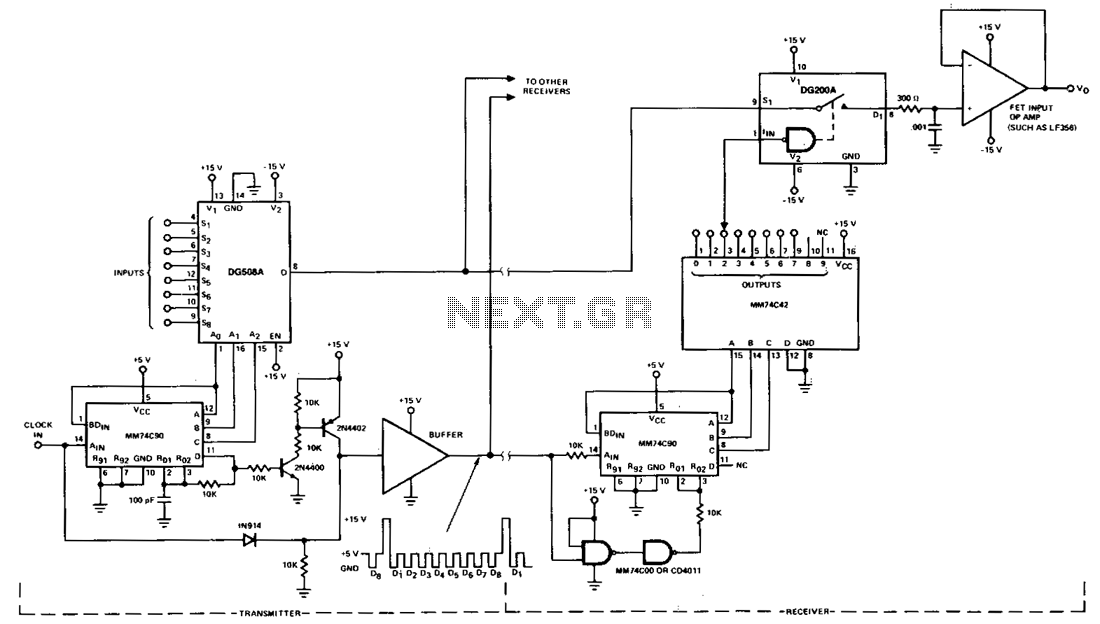
10F8-channel-transmission-system

This circuit illustrates a typical multiplex system designed to transmit one of eight inputs to a remote location. A 5-V pulse train is transmitted through a separate channel to execute timing and synchronization functions. A 15-V reset pulse is superimposed on the 5-V clock, which is detected by the MM74COO at the receiver. This system enables monitoring of multiple remote points, one at a time, from various locations.
The described multiplexing circuit employs a systematic approach to manage multiple input signals efficiently. The core of the system consists of an 8-to-1 multiplexer, which selects one of eight input channels based on the binary address provided by a control logic circuit. The 5-V pulse train serves as the clock signal, ensuring that the multiplexer operates in synchrony with the timing requirements of the system.
The reset pulse, operating at 15 V, is crucial for initializing the system and ensuring that the multiplexer starts from a known state. This pulse is superimposed on the clock signal, allowing the MM74COO, a dual D-type flip-flop, to detect and respond to both the clock and reset signals. The flip-flop captures the state of the selected input at each clock edge, thereby maintaining the integrity of the data being transmitted.
The output of the multiplexer can be directed to various monitoring locations, allowing for efficient data collection from multiple remote points. This capability is particularly useful in applications such as environmental monitoring, industrial automation, and telemetry systems where real-time data acquisition is essential.
Overall, this circuit design exemplifies effective use of multiplexing techniques and timing synchronization, providing a robust solution for remote data monitoring and control.This circuit shows a typical multiplex system intended to carry one of 8 inputs into a remote location. A 5-V pulse train is sent down a separate channel to perform timing and synchronizing functions. A 15-V reset pulse is superimposed on the 5-V clock, which is detected by the MM74COO in the receiver.
Using this system, many remote points can be monitored, orie at a time, at any of several locations. 🔗 External reference
The described multiplexing circuit employs a systematic approach to manage multiple input signals efficiently. The core of the system consists of an 8-to-1 multiplexer, which selects one of eight input channels based on the binary address provided by a control logic circuit. The 5-V pulse train serves as the clock signal, ensuring that the multiplexer operates in synchrony with the timing requirements of the system.
The reset pulse, operating at 15 V, is crucial for initializing the system and ensuring that the multiplexer starts from a known state. This pulse is superimposed on the clock signal, allowing the MM74COO, a dual D-type flip-flop, to detect and respond to both the clock and reset signals. The flip-flop captures the state of the selected input at each clock edge, thereby maintaining the integrity of the data being transmitted.
The output of the multiplexer can be directed to various monitoring locations, allowing for efficient data collection from multiple remote points. This capability is particularly useful in applications such as environmental monitoring, industrial automation, and telemetry systems where real-time data acquisition is essential.
Overall, this circuit design exemplifies effective use of multiplexing techniques and timing synchronization, providing a robust solution for remote data monitoring and control.This circuit shows a typical multiplex system intended to carry one of 8 inputs into a remote location. A 5-V pulse train is sent down a separate channel to perform timing and synchronizing functions. A 15-V reset pulse is superimposed on the 5-V clock, which is detected by the MM74COO in the receiver.
Using this system, many remote points can be monitored, orie at a time, at any of several locations. 🔗 External reference